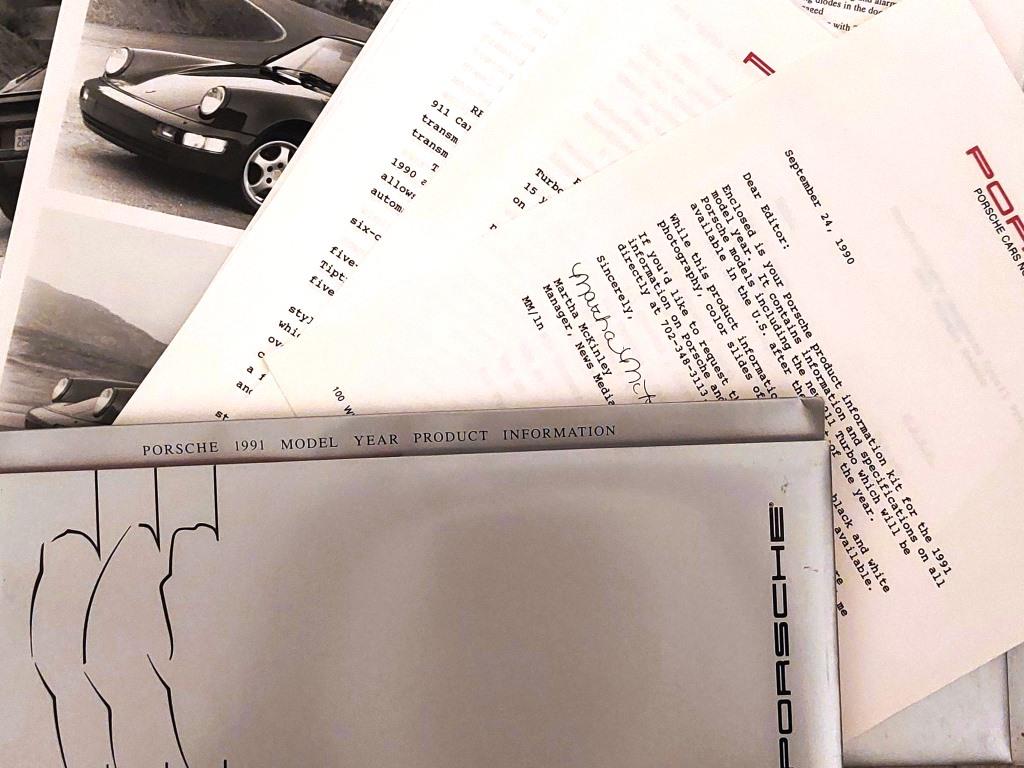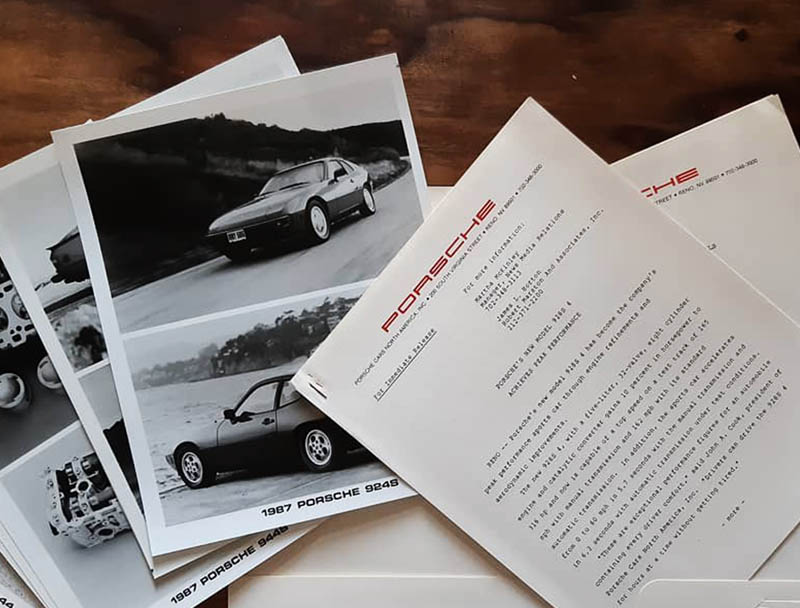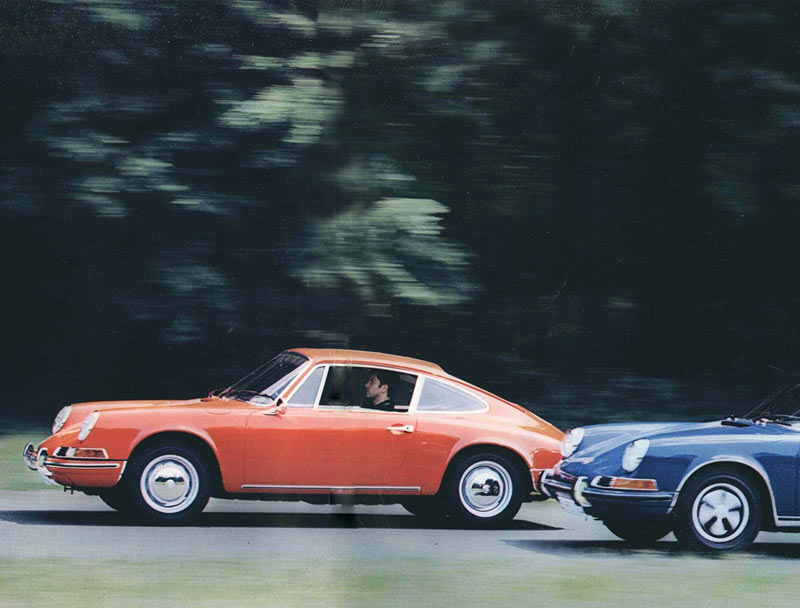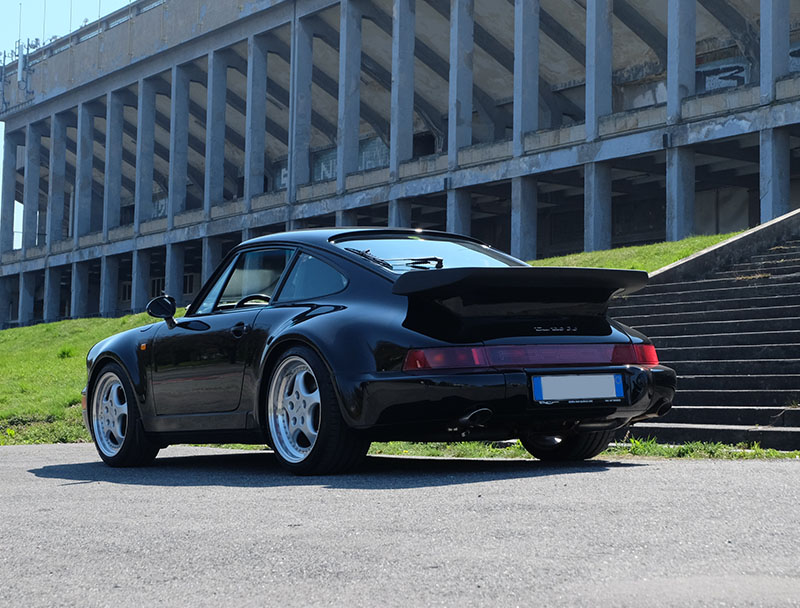
1990 - All the production

La cartella del modello 1991 per il mercato USA, consegnata alla stampa nel settembre 1990, include i modelli 964: C2, C4 e soprattutto la nuovissima (per l'epoca) Turbo, nuovamente introdotto con il "vecchio" motore 930 portato a 320 cv ed i modelli transaxle 944 S2 e l'ammiraglia 928 nelle versioni "S4" e la piu' sportiva "GT".
Non mancano informazioni tecniche dettagliate per ogni modello e le curve caratteristiche di potenza e coppia, queste ultime incluse nella nostra galleria.
.jpg)
September 24, 1990
Dear Editor:
Enclosed is your Porsche product information kit for the 1991 model year. It contains information and specifications on all Porsche models including the new 911 Turbo which will be available in the U.S. after the first of the year.
While this product information kit contains black and white photography, color slides of all our models are available.
If you'd like to request the slides or if you need more information on Porsche and Porsche products, please call me directly at 702-348-3113.
.jpg)
RENO, NEVADA, November 28, 1990 -- The 1991 Porsche 911 Turbo is the embodiment of two long-established traditions of Porsche product engineering. It represents the direct use of racing experience and technology to improve the sports car breed and the Porsche philosophy of ensuring that all aspects of vehicle performance are engineered in balance with each other.
The Porsche 911 Turbo was last sold in the United States as a 1989 model The new 1991 911 Turbo returns with six-cylinder a "boxer" engine of the same 3.3-liter size as the previous sports car, yet it features 33 more horsepower. Power output of the new model is 315 hp, and torque is rated at 332 foot pounds, up by a full 15 percent over the previous model's torque rating.
While it is certainly not impossible to reach such power improvements in performance engines, it is seldom possible to achieve so much improvement without increasing engine displacement. Engineers at Porsche's world-renowned Weissach development center drew upon the approach used by the race engine developers in their midst. They accomplished the virtually impossible feat of achieving large power gains with no displacement increase while at the same time keeping emissions low. Furthermore, despite the high power output of the 911 Turbo, it remains a practical and tractable vehicle which can be driven docilely at low speeds in everyday use.
Porsche's strategy was to apply the results of many small steps to produce large results. Changes made to the engine control system, turbocharger, intake system, intercooler and exhaust system produced the gains.
The turbo unit itself was replaced by a new version with a larger, lower mass turbine wheel for higher top boost pressure and better response.
After the intake air is boosted by the turbocharger, it passes through a redesigned, air-to-air cooler called the intercooler. The intercooler cools and increases the density of the intake air after it is heated by the red-hot exhaust-driven turbo. Porsche engineers increased the size of the intercooler and carefully "flowed" it - the racing engineer's term for reducing internal flow restrictions. Thus, intercooler "throughput" (which can limit turbocharger efficiency like the nozzle on a garden hose limits the flow of water) has been increased. The lower internal restriction to intercooler airflow means a higher effective cylinder supercharging effect.
Still working on the intake system, Porsche engineers continued to draw on the racing developer 's method of using many small and even artistic changes to help produce large power gains. Changes in the intake system and intercooler, for example, involved careful, and in some cases, tiny re-profiling of passages and corners, which in turn optimized airflow and increased power.
Not stopping with the intake system, however, Porsche paid attention to the other side of the equation - exhaust flow Reducing exhaust back pressure was the goal, and it was achieved to the tune of a 30-percent reduction. One key element in the exhaust efficiency improvement is the metal honeycomb catalytic converter, which not only reduces backpressure, but also does a more efficient job of cleaning exhaust emissions.
The second principle of Porsche sports car design is to engineer all aspects of vehicle performance in balance. It is not sufficient to add torque and horsepower if the chassis isn't simultaneously prepared. That was the principle behind the all-around chassis upgrade of the 911 Turbo of 1976, and that remains the design principle of the new 1991 911 Turbo.
Starting with the brakes, they are a four-piston, fixed caliper design.The calipers are enormous in size and strength and yet are lightweight, being of an aluminum alloy similar to that used for heat resistance in engine pistons. The matching brake discs are internally vented for heat dissipation and are cross-drilled. Not simply iron discs, they are of a specific alloy which has been race-proven by Porsche for minimum wear and maximum heat dissipation
Controlled by a sophisticated anti-locking system and cooled by being integrated with the airflow management of the vehicle the 911 Turbo brakes are arguably the most powerful brakes on any regular production vehicle available the world over While such German-engineered stopping power is critical to the overall balance of performance on the new 911 Turbo, handling has been upgraded to match the vehicle's new performance level as well. The suspension is new to the Turbo, utilizing coil springs over tubular shock absorbers at all four corners. In addition, the rear suspension design provides track-correcting semi-trailing arms, which work in combination with an all-new type of limited slip differential, 17-inch alloy wheels and ZR-rated tires to provide extremely high levels of handling control.
The new differential is itself a particularly worthwhile piece of Porsche engineering. It makes the new 911 Turbo the world's only vehicle with a simple, mechanical control for slippage which varies between a mild 20 percent on acceleration (to prevent one rear wheel from breaking traction) to a 100-percent locking factor under braking. Normally, a mechanical limited slip system provides only a single, compromise percentage of slip control.
The race-bred engineering, the careful balancing of capabilities, the sheer performance, the body strength and integrity, the durability and classic style of the new 911 Turbo make it a worthy successor to its legendary predecessor.
| MODEL | M.S.R.P. |
|---|---|
| 944 S2 Coupe | $43,350 |
| 944 S2 Cabriolet | $50,350 |
| 911 Carrera 2 Coupe | $60,700 |
| 911 Carrera 2 Coupe Tiptronic | $63,650 |
| 911 Carrera 2 Targa | $62,200 |
| 911 Carrera 2 Targa Tiptronic | $65,150 |
| 911 Carrera 2 Cabriolet | $69,300 |
| 911 Carrera 2 Cabriolet Tiptronic | $72,250 |
| 911 Carrera 4 Coupe | $72,000 |
| 911 Carrera 4 Targa | $73,500 |
| 911 Carrera 4 Cabriolet | $80,600 |
| 928 S4 | $77,500 |
| 928 GT | $77,500 |
| 911 Turbo | $95,000 |

1990 - All the production

1992 - All the productions

Porsche Press kit

Porsche Literature

Our Porsche Cars